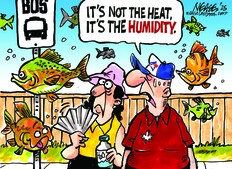Canadian road deaths down 18% over 10 years, U.S. up 33%
“The U.S. could learn a lot from our northern neighbour”: Insurance Institute for Highway Safety President David Harkey

Article content
Add driving to the many things — not blaming our neighbours, not bullying our neighbours, and, well, most definitely not shooting our neighbours — that Canadians do better than our Yankee friends to the south. The contrast is, in fact, so great that in a joint press release from the U.S. Insurance Institute for Highway Safety (IIHS) and our own Traffic Injury Research Foundation (TIRF), IIHS President David Harkey said, “The U.S. could learn a lot from our northern neighbour.”
The numbers truly are one-sided. Dramatically so. In the decade between 2011 and 2021, American annual road fatalities rose some 33%, from 32,479 in 2011; to 43,320 in 2021. In Canada, on the other hand, road fatalities actually declined 18%, from 2,166 to 1,776. And, as the IIHS notes, that is despite the fact that Canada’s population, number of drivers, and even miles driven all increased more than America’s over the same period. Do some basic math and those statistics mean that 46 out of every million Canadians died in a road collision in 2021. In America, that number was 131 per million.
Recommended Videos
In fact, according to the report, the U.S. has the highest per-capita crash fatality rate amongst the 29 highest-income countries. Worse yet, America’s death rate was twice the average of the other 28. “Many of the countries that managed to improve road safety in recent years have leaned into the Safe System framework, which approaches risks from all angles to create overlapping layers of protection and ensure that no single mistake is fatal,” said IIHS Senior Research Scientist Becca Weast, a co-author of the new paper. “Canada’s policies reflect that approach.”

What makes this most embarrassing — make that “tragic” — for our Yankee friends is the IIHS’ assertion that the “specific crash types that were associated with the biggest fatality increases in the U.S. were the same types that went down by large percentages in Canada.”
So, for instance, while pedestrian and cyclist fatalities increased a whopping 64% in the U.S., they fell by 17% here in Canada. Fatalities involving large trucks increased 54% south of the border, but decreased 24% north of the 49th. Perhaps most incredibly, auto-related deaths involving young drivers dropped 52% in the Great White Frozen North, but they were up 17% in the U.S. Deaths involving alcohol were likewise up in the United States but fewer in Canada.
What makes this all the sadder is that U.S. and Canadian fatalities per miles driven were basically the same until about 2013, after which Canadian rates continued to decline while America’s skyrocketed. As to the why, that might defy easy — or even comprehensive — explanation, but the study does posit some reasons.
For one thing, distracted-driving and seat-belt laws are stronger here than in America, and apply to a greater percentage of Canadian drivers than Americans. For another, all Canadian provinces, save for Quebec, have administrative penalties for driving with a blood-alcohol concentration (BAC) between 0.05% and 0.08%. Such laws are rare in America. In addition, Canadian police can demand a roadside breath test from any driver without suspicion of impairment, as is required in the U.S.

Pooh-pooh our relative lack of freedom all you want, but we’re killing 65% fewer motorists and pedestrians as a result of these more stringent — but admittedly less libertarian — laws. Craig Lyon, director of road safety engineering at TIRF and the new paper’s lead author, says this “demonstrates the real-world potential impact of evidence-based policies in terms of lives saved.”
Meanwhile the IIHS’s Harkey points out that there are some things that America can pick up from its recalcitrant 51st-state-to-be: “Our countries are culturally very similar, so there is reason to believe that many policies that work there could help the U.S. get back on the right track when it comes to road safety.” It really is sad that, in this day and age of automatic braking, lane-change warning systems, and all the other safety systems designed specifically to make the operation of an automobile easier and safer, that our Yankee friends are somehow managing to screw that up, too.
Sign up for our newsletter Blind-Spot Monitor and follow our social channels on X, Tiktok and LinkedIn to stay up to date on the latest automotive news, reviews, car culture, and vehicle shopping advice.















Postmedia is committed to maintaining a lively but civil forum for discussion. Please keep comments relevant and respectful. Comments may take up to an hour to appear on the site. You will receive an email if there is a reply to your comment, an update to a thread you follow or if a user you follow comments. Visit our Community Guidelines for more information.